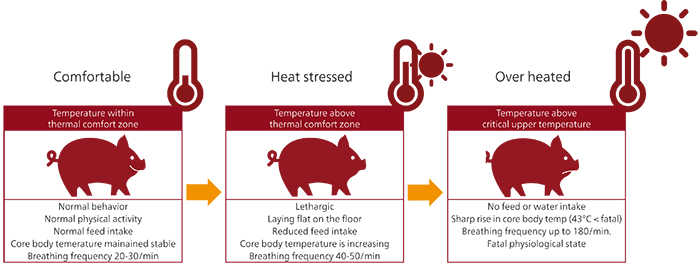Facts about heat stress in swine
Our climate is changing. Periods of heat stress for farm animals will increase in frequency and/or in length. This will - among other things - affect the welfare and production capacity in swine production. Let’s review some facts about heat stress in swine. Keep an eye out the next few weeks as we explore some of the problems that occur and some of the support options that can help the animals to cope with periods of heat.
This article is part of a 3 part series. After you have read this part, read:
- Part 2: Heat stress problems in swine >>
- Part 3: Support options for pigs experiencing heat stress >>
Facts
Pigs are endotherms, they generate their own internal body heat and possess self-regulating processes to maintain their core body temperature within a certain interval optimal for survival. For pigs, this interval is 38.7- 40.0 °C. Heat stress occurs when the pig is unable to maintain its body core temperature within this optimal interval 38.7- 40.0 °C.
Fact: the upper temperature of the thermo neutral zone varies
If the temperature increases above the pig’s thermo neutral zone they will need help to maintain their body core temperature. What this thermo neutral zone is, depends on age, size and reproductive status but also humidity, ventilation and other environmental factors. Table 1 shows the approximate temperature where a decrease in performance due to high temperatures can be observed.
Table 1. The temperatures were heat stress starts to impact animal productivity. In large animals the negative effects can already be seen at a quite modest temperature increase.
|
Animal category |
Ambient temperature |
|
Pig 25 kg |
27 °C |
|
Pig 50 kg |
25 °C |
|
Pig 75 kg |
23 °C |
|
Nursery sow |
22 °C |
Fact: pigs can dissipate body heat via radiation, conduction, convection and evaporation
A feral pig would seek out shade and a nice mud pool were the body heat can be conducted to the cool water. This strategy to seek out a new environment is usually not an option for production animals. Instead they try to find a spot where they can lie flat on the floor and convey heat to the concrete if possible. The most effective way to help pigs to lose heat is to adapt their environment by providing shade, air conditioned houses, install fans, sprinklers etc. but this is very costly.
Fact: Pigs are more sensitive to heat stress that other farm animals
This is due to the fact that pigs barely have any sweat glands, they have relatively small lungs compared to their body size and they have a thick subcutaneous layer of adipose tissue.
Fact: Today’s highly productive pigs generate more endogenous heat resulting in reduced tolerance to heat stress
Modern breeds are genetically selected for their productive traits such as lean tissue accretion, high milk yield and high prolificacy and as such produce more endogenous heat making them more vulnerable to heat stress.

Figure 1. Overview of changes in animal behavior when temperature changes from comfortable to life critical.
Keep an eye on perstorp.com or our Animal Nutrition social media channels the next few weeks as we explore some of the problems that occur and some of the support options that can help the animals to cope with periods of heat.
Continue reading:
- Part 2: Heat stress problems in swine >>